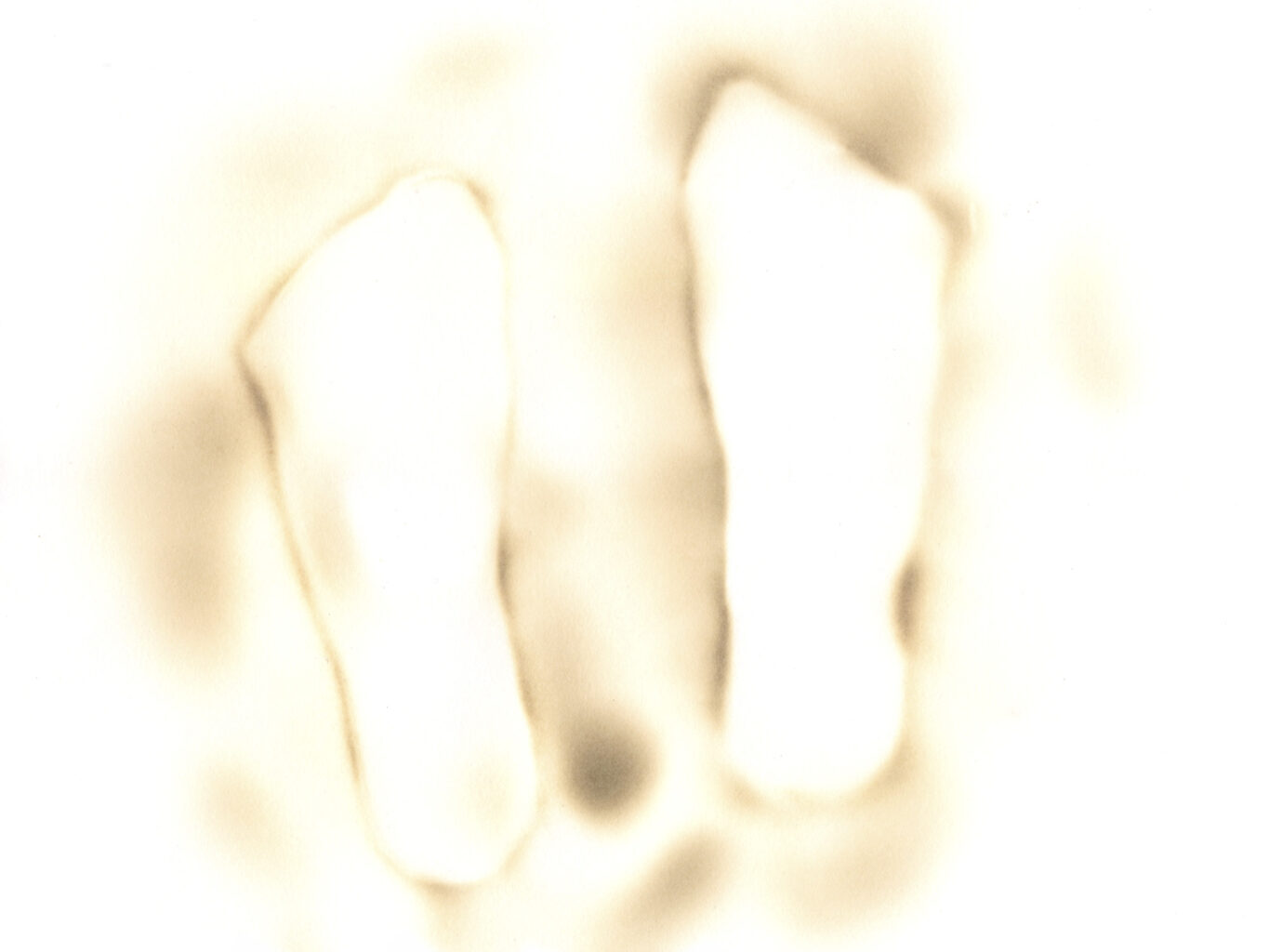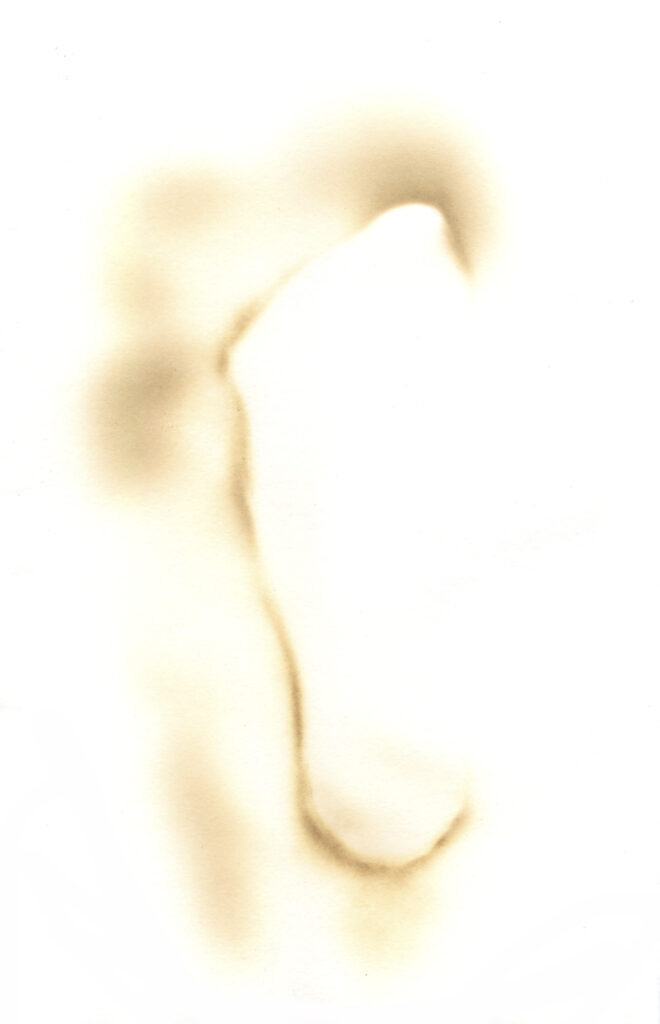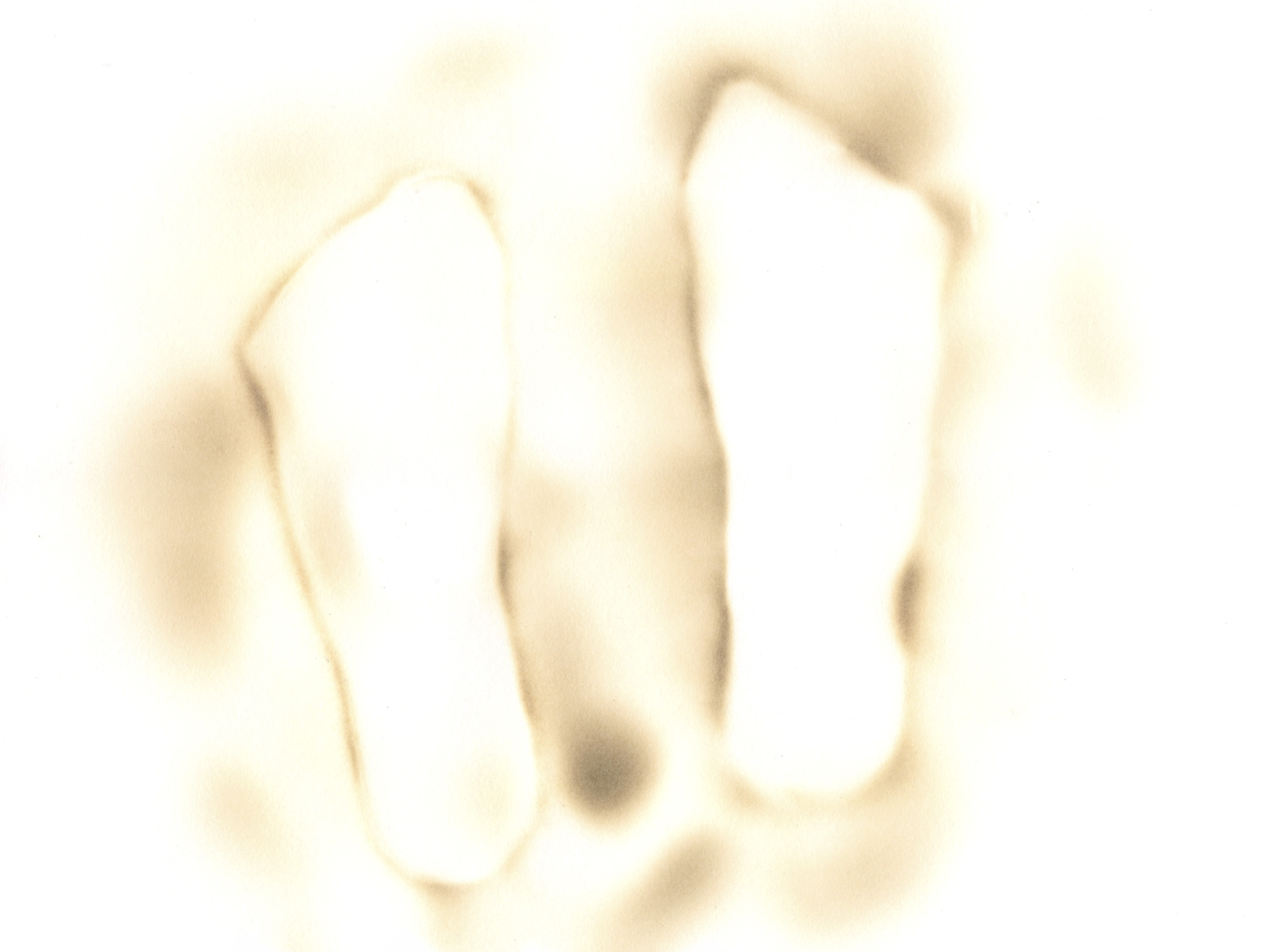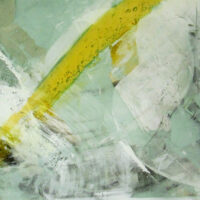Between Ascension and Whitsun, the Earth’s question enters humanity like a seed. Will we bear witness to the bequest of the Earth—will we become active?
Many years ago, during one of my first visits to the Holy Land, I was suddenly struck by the thought that, where I was walking, I was possibly following in the footsteps of another wanderer. Of the wanderer, in essence. Of the person wholly other. It was on the shore of the Sea of Galilee. I realised, of course, that the ground I was walking on was no longer the same as it was two thousand years ago. I was aware of how people had continued travelling there since then, wanting to walk in these tracks. But what does “a track” mean? Is there still a track? A track is not the same as an imprint. A track has an effect. Effectivity is always present, no matter how long ago the track was created. Effectivity is the present. What caught hold of me was this presence and its reality.
Would this mean that he, the great wanderer, was always there? Is it enough that I forge a path for myself and thus permit his presence, simply walking on the Earth with my feet? For a long time, I understood the expression “walking in the footsteps of another” to be a poetic statement, but not a real thing in itself. Presence is deeply unsettling. Was I equal to this reality?
Parting
Who hasn’t hoped at the moment of parting that the person who has just departed will return? If not immediately, then soon. The person who has just crossed the threshold of the house or the threshold of death and moves ever further away until they disappear completely from view. He will return!
Only later do we come to realise: this person has crossed the boundary of the imaginable and left it behind. He did not stop, he did not look around, he did not reconsider, and he did not return on his way—neither metaphorically nor literally. We stand there helpless and abandoned, and a silence sets in that we have never experienced before. We continue to look for the person who departed. If only I could reach him for another moment! Just once more! The relentlessness of “never” begins.
When someone I was close to moves into the distance and can no longer be reached, a profound pain arises. The silence that then envelops us feels like whiteness. Like a cloud.
Rarely has a farewell been described in such succinct words as when he bade farewell to his own: “And when he had spoken these things, while they beheld, he was taken up; and a cloud received him out of their sight.” (Acts 1:9, King James Version) So much in the group of disciples was still unclear; there were still questions to be asked, to be understood. So many things that one or the other of them had always put off and would have liked to tell him one day—the most intimate, that was at the same time the most mysterious. That which they saved only for him. Had he not said that he would stay with them until the end of time? They still had time to open their hearts to him, didn’t they?
How was it that he suddenly commanded them to stay in Jerusalem, to wait, and not to ask about times and deadlines? There was talk of the power of the Holy Spirit and that they should become witnesses. The last word that went out to them was “Earth”—become witnesses unto the uttermost part of the Earth. “Et usque ad ultimum terrae.” In the original text, this limit is also chronological. Until the end of Earth time (“Eschaton”)—”Earth”.
This is the earth they were standing on. He had begun to ascend; his feet were no longer on the Earth. First one, then the other freed itself from solid ground. He departed from the Earth; he departed from them all, “While he blessed them,” writes Luke (24:50-51, King James Version). The unimaginable was happening before their eyes. They looked up higher and higher. They were no longer anything but helpless observers. Many things beyond their imagination had happened in the last forty days: the empty tomb, how he had shown himself to them again, how he had broken bread with them and walked the Earth with them. Although they didn’t understand it yet, they accepted it immediately.
Their eyes follow him as he departs; no one notices the tracks.
Now, a cloud floated past and interposed itself between him and those still standing on the Earth. At the highest point of the garden on the Mount of Olives, they stood with their feet on a hard rock. And with a hope that slowly evaporated like a cloud in the sky. He could no longer be seen. The last they saw of him were his feet. The time of mourning had come.
Celestial Journeys and Ascension
There are many celestial journeys. But this time, it wasn’t one because a person can come back from a celestial journey and tell of it. There can be a “legacy” because something is left behind. In his ascent to the paradisiacal vision of light, Dante is led by Beatrice to the very edge of the celestial rose, to where all language ceases and love sets the universe in motion. (Paradiso, Canto XXXIII, 145) It is not until his Commedia Divina that language is reborn out of Dante. There are also verses in the Koran that tell of the celestial journey in the night of the Prophet Muhammad to the throne of God, to the holy place where he saw the signs of God. From this vision, Muhammad brings back the cosmic order of the prayer times. (Quran, 17:1)
Nor is the Ascension a journey like the one Elijah undertook in the fiery chariot, amid flames and lightning, through the heavenly spheres. Elisha, who is supposed to follow him, stays behind and is overwhelmed by the pain of parting. Shortly before, the two of them had wandered as far as the Jordan, which had parted with a stroke of Elijah’s coat so that they could cross the river. “My father! My father!” cried Elisha as the storm wind carried Elijah upwards, standing on the chariot drawn by horses of fire. Only then does he find the cloak left behind by Elijah on Earth. (Bible, Book of Kings, Chapter 2.)
What was left behind at the ascension of Christ? Was anything left behind? The promise of the two angels after he had moved completely out of their sight? Or had the disciples overlooked something?

In the West, Christian iconography depicted this event for centuries in such a way that the Ascension could be followed throughout the entire ascent. Starting with the depictions in which Christ is still standing with one foot on the Earth, as if he were about to climb the ladder to heaven. Then, there are images that show all the stages of the increasing distance between Christ and the Earth, right up to the very last moments, in which his head is already covered by the cloud and only the hem of his robe remains visible. And below it, his feet—always his feet.
Until the early seventeenth century, there were depictions in Western Christian illuminated manuscripts and carved images in which the visible footprints were impressed in a stone. The disciples crowd around this stone from which Christ ascends to heaven. Their eyes follow him as he departs; no one notices the tracks.
As a Single Greening Spot
In Jerusalem, on the highest point of the Mount of Olives, is the Chapel of the Ascension. According to tradition, Christ ascended to heaven from here, and the disciples are said to have stood here while they looked up into the heavens and watched the event with their eyes. In the chapel today, there is a stone slab at a lower level on which the footprints of Christ, which he left behind during the Ascension, can be seen and venerated.
The earliest records do not mention stone impressions. There were tracks in the grass around which a round building, open at the top (and later a church surrounding this simple building), was erected. Was this first building like a shrine of the heart? How can the living tracks in this shrine be protected—how can the living seeds in the earth be protected? Although the source material is extremely limited, this question proves to be a central theme in the correspondence between Paulinus of Nola (353/355 to 404/413) and his friend from Aquitaine, Sulpicius Severus (363 to ca. 420), which took place at the beginning of the fifth century.
The tradition of worshipping these footprints is said to have begun in the earliest communities. There is talk of footprints in the dust or tracks in the grass. Can there be anything more fleeting than traces left in dust? How can the permanent also be fleeting and the fleeting permanent? It was not until centuries later, at the time of the Crusades, that the first reports of imprints in the rock emerged.
Thus, around 401/402, Paulinus writes to his friend, who is apparently of the opinion that the tracks were covered with a marble slab and safeguarded, that the ground sanctified by the divine footprints could not have been covered with marble because the stones had jumped into the faces of the workmen when they tried to pave the floor of the church. In this way, the ground with the footprints had been preserved in its original form as grass.
As further proof, Paul cites evidence that these tracks are still recognisable because the Earth has preserved them to this day. It is not people who are responsible for this protection; the Earth has received this bequest! He describes the tracks inside the building as: “a single green spot in the basilica”. Green, “virens”—that which is greening—is what the letter says. It is about a life-giving force: something lasting that always bestows new life. This is exactly what Sulpicius Severus also describes in his chronicle from the year 402: the outlines of Christ’s feet imprinted in the dust had been preserved, although pilgrims had repeatedly taken earth away with them from this sacred place. “It is the Earth that has preserved them, the footprints.”
In the Legenda Aurea, written between 1265 and 1267, some of their arguments were included, but in the version of the Legenda Aurea, the ‘”tracks” had already been transformed into “imprints” in a boulder, as it says in the text on the Ascension. The roof was no longer open to the heavens.
The Abbot in Iona
Pilgrimages to the Holy Land have never ceased from the first centuries onwards. It was a constant back and forth, either by land or by sea. The high frequency of the journeys contrasts with the small number of travellers’ reports that have reached the West.
One of the first descriptions of the journey known in the West, with maps and plans of Jerusalem and other places, was written by Arculf, a pilgrim and bishop from Gaul, on his journey to the Holy Land and during his nine-month stay in Jerusalem. This journey is said to have taken place around the year 680. He gave his findings and sketches as an oral report to the Irish monk Adomnán or Adamnanus (628–704), abbot of the monastery of Iona. Arculf, of whom only these few facts remain known, had been given shelter by the abbot after being shipwrecked off the coast of the Hebrides on his return voyage. Adomnán succeeded in integrating the travel descriptions with plan drawings and maps in his work De Locis sanctis libri tres, a travel book that he wrote for pilgrims and which became known as such in the early Middle Ages.
In the first of the three volumes of the book, the Ascension Chapel in Jerusalem is described on the basis of Arculf’s reports and illustrated with his drawings. Arculf is said to have put these on wax tablets. His drawings include one depicting the interior of the Ascension Chapel, a circular building with the footprints in the centre. Tracks in the earth! This is the oldest known sketch of a number of sacred buildings in the Holy Land.
In the time before Constantine, when Christians were persecuted, the first Christian communities commemorated the Ascension of Christ in a cave near the highest summit of the Mount of Olives. Between 384 and 392, a building was erected around the footprints that had been left in the ground. The structure was built precisely on the clod of earth that bore the footprints of the Lord. The benefactor of the simple, round chapel with an open roof was a certain Poimenia, a Christian woman from a noble Roman family. Over the centuries, the building has had a long and complex history of repeated destruction and reconstruction. When the crusaders reached Jerusalem in 1099, they climbed up the Mount of Olives to this place. A “stone” was mentioned for the first time in the chronicles of Petrus Tudeboldus. The stone with the footprints mentioned by Tudeboldus was incorporated into the subsequently renovated church. Between 1102 and 1106, crusaders rebuilt what had begun as a simple round building and added a colonnade. In 1187, under Saladin (1138–1193), who conquered Jerusalem, a mosque was built adjacently, whose walled courtyard framed the church. To this day, there is still an octagonal, round building on the same site, which corresponds to the original round building and was erected after the church fell into disrepair. In the pilgrims’ reports after the Ascension Mosque was built, there was no longer talk of tracks in the dust of the greening Earth, “terra virens”, but of an imprint on a boulder.
Tracks and Imprints
Tracks move through time. An imprint is made once. Both bear witness to someone having been present. An imprint is more about the revelation of this presence, about pure being—”He is.” Tracks are about the effectivity of the person present—”He will become.”
Is there a more delicate touch than when a foot sets itself down on the Earth? Sensing it as if in greeting and feeling its counter-pressure like a return greeting, with every step?
As soon as we stand upright, we try to place our very first steps on solid ground. The vertical evokes the horizontal. Walking takes place in the horizontal plane. No person can walk in the air. There is no talk of celestial journeys. The Earth is the ground of all of us, and there is only one.
As soon as we walk, the foot presses against the Earth with every step. The foot sets itself down, pushes off and rises again to set itself down again. If we want to do this with both feet at the same time, we jump. A step means one foot after the other. This is how we leave a track of our wanderings on the world.
The almost four-year-old holding my hand looks back with every step at his tracks in the snow and suddenly says: “Look, my feet are stepping on the Earth.” Clearly, he experiences this “on” very intensely. We look at these tracks for a brief moment. They are already giving up their forms in the melting snow. He greeted the Earth, and it greeted him. There are three of us, the Earth forming the link. And suddenly, there is a lot of intimacy.

The young mother who has developed multiple sclerosis and can no longer walk has just one single wish: to be able to put her feet on the ground herself once more. Friends lift her out of her wheelchair. Her feet probe the air and hover above the ground but do not reach it.
“On Earth” is not a metaphor or imagery that means we are here in this world and move across it until, at some point, things come to an end. “On Earth” should be taken quite literally. Being and walking in the world means setting foot on the Earth in such a way that it reveals itself and its effectivity can blossom. We are surrounded by animals, plants, rivers, lakes, oceans, farmland and forests, which we conveniently call “nature” so that we can withdraw into ourselves. To this end, our ecological footprint, which is simple to calculate, should also be as light as possible! But: “The Earth is waiting for my footprint.”1
When will we bear witness to what is present, not what is past?
The Earth wants to be touched, wants to feel our steps. Steps that connect our becoming lighter with its becoming more enduring. Steps that bless it anew each time! Has the Earth not received the tracks of the Saviour, and does it not bear his effectivity so that we can transform petrification into a completely new substance that is both fleeting and enduring? And the Earth into a single green spot as a basilica in the new cosmos?
Whitsun
We stand on the Earth on which the disciples stood, bewildered, as they were—overwhelmed by the inconceivable. We still look up with anxious hearts until someone finally comes back and frees us from this dull hopelessness, this inertia of the heart. Or do we just simply stare blankly ahead of us, overwhelmed by our position as onlookers and barely able any longer to venture a look into the depths of contemporary events? Have we unlearned the language of the feet? Or have we not yet reversed our gaze because we continue to look to where we expect our salvation from emptiness and powerlessness to come from?
We are like the disciples who stand around the footprints and cannot see them. Have we already detected the tracks of the one who lives? Do we know the language of that wanderer on Earth—whatever his name may be—whose feet have imprinted a whole new word in the fleeting dust of our being? Or do we remain trapped in the sorrow of a farewell that is not a farewell? When will we bear witness to what is present, not what is past? When will we bear witness to the event that we cannot grasp unless we bear witness to it?
The book of Acts tells how in the days immediately after the Ascension, when the disciples had returned to Jerusalem, the question of “becoming a witness” circulated among them and their circle of friends: “Wherefore of these men which have companied with us all the time that the Lord Jesus went in and out among us, beginning from the baptism of John, unto that same day that he was taken up from us, must one be ordained to be a witness with us of his resurrection.” (Acts 1:21, 22, King James Version)
A lot of sorrow still resonates in it—sorrow in the familiar language! Sorrow about something that has happened. The resurrection is the central event—it is important to bear witness to it. But how do we talk about it?
With Whitsun, a new language bursts forth with overwhelming power. The Holy Spirit, in a mighty roar, poured out this language on each disciple like individual flames of fire, and instantly, they stepped out of their inner captivity. They only had to speak, and the presence of the Risen One took effect, and all who were with them understood as if it were their own language. The living Word spoke from each of them, and they began to walk on the Earth and touch it. With each step, the Earth and heart were infused with greening, living power. Both became the shrine in which his everlasting language grows—the language of the feet, the Word, the Logos to the end of time.
Translation Christian von Arnim
Illustration Graphics team of the Goetheanum Weekly
Footnotes
- Ueli Hurter, quoted from: Lin Bautze, I Want to Walk on Earth, the Goetheanum Weekly, November 10, 2023.






Very inspiring reading. Thank you!